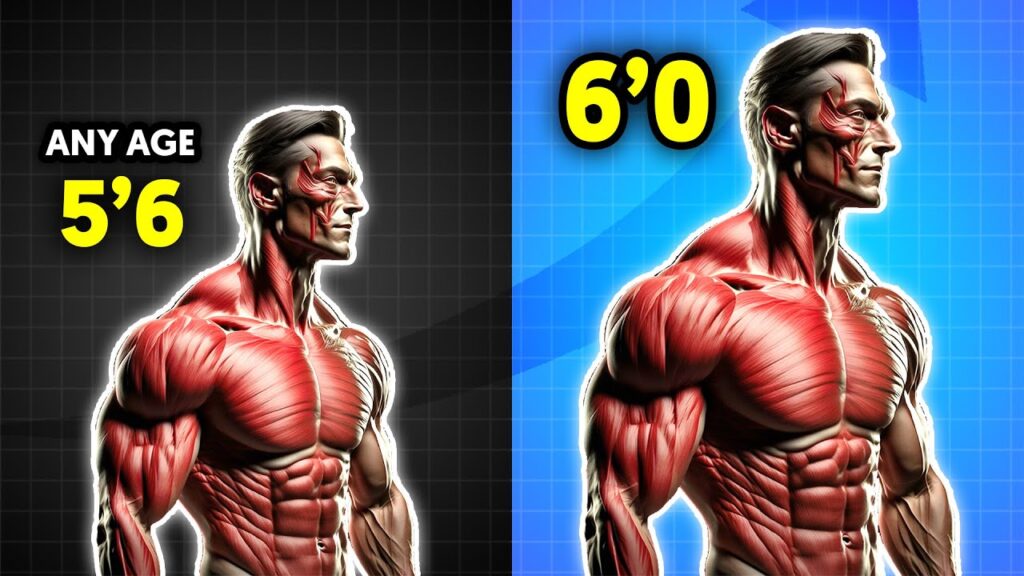In the video titled “Stay Active and Exercise for Height Growth” by Body Hub, you’ll learn about the various things you can do to increase your height, even beyond your maximum genetic potential. While it may be challenging to grow taller as an adult, there are still some strategies you can implement. The video explores the importance of strengthening your core, practicing good posture, engaging in yoga exercises, and staying active through regular exercise. By following these practices, you may be able to make small but noticeable changes in your height. So, if you’ve ever dreamt of being taller, this video is certainly worth a watch.

Importance of Exercise
Exercise for Growth Plates
Exercise can play a significant role in the growth and development of your body, even beyond your maximum genetic height. While it is true that height has limited room for improvement compared to weight, there are still things you can do to maximize your potential height. One factor to consider is the growth plates in your bones, which typically become solid around the ages of 18 to 20. However, regular exercise can still have a positive impact on your height by decompressing the spinal discs.
When you engage in exercises that involve stretching and decompressing the spine, you can create space between the vertebrae and relieve any compressive forces that may have accumulated throughout the day. Daily activities such as hunching over a desk can lead to compression of the spinal discs, causing a slight decrease in height. By incorporating exercises that target the growth plates and promote spinal decompression, you can counteract this effect and potentially increase your height, even if it’s only by a small amount.
Exercise for Spinal Decompression
Regular exercise is beneficial for maintaining good posture, spinal health, and overall physical well-being. When it comes to spinal decompression, certain exercises can help alleviate compression and create more space between the vertebrae. Some effective exercises include hanging from a pull-up bar or using an inversion table to allow gravity to decompress your spine. Additionally, exercises that engage the core muscles, such as planks and yoga poses, can also contribute to spinal decompression.
By incorporating these exercises into your routine, you can help alleviate spinal compression and create a more conducive environment for your spine to grow and develop properly. While the changes in height may be minimal, the overall health benefits of spinal decompression and good posture are worth considering.
Exercise for Bone Density
Exercise is not only beneficial for growth plates and spinal decompression but also plays a crucial role in maintaining and improving bone density. Weight-bearing exercises and high-intensity activities, such as running, jumping, and strength training, stimulate bone remodeling and increase bone density. These activities help strengthen the skeletal system and reduce the risk of osteoporosis, a condition where bones weaken and become more susceptible to fractures.
Engaging in weight-bearing exercises forces your bones to support the weight of your body, which stimulates the development of stronger and denser bones. High-intensity activities, on the other hand, put stress on the bones, leading to bone remodeling and increased density over time. By incorporating these types of exercises into your fitness routine, you can improve your overall bone health and reduce the risk of osteoporosis.
Strengthening the Core
Importance of a Strong Core
Having a strong core is vital for maintaining good posture, spinal stability, and overall body strength. The core muscles, which include the muscles in your abdomen and along your spinal column, play a crucial role in supporting and stabilizing the spine. When these muscles are weak, it can lead to poor posture, spinal compression, and a shorter appearance.
A strong core helps maintain proper alignment of the spine, reducing the risk of compression and maintaining a taller posture. It also improves stability and balance, allowing you to engage in physical activities with ease. Strengthening your core muscles through targeted exercises can significantly contribute to better posture and overall physical well-being.
Exercises for Core Strengthening
There are various exercises you can incorporate into your fitness routine to strengthen your core muscles. One of the most effective exercises is the plank, which involves holding a push-up position while engaging your core muscles. This exercise targets multiple muscle groups in the core, including the rectus abdominis, transverse abdominis, and obliques.
Another effective exercise for core strengthening is the Superman exercise. This exercise involves lying face down on the floor and simultaneously lifting your arms, legs, and upper body off the ground. The Superman exercise targets the muscles in your lower back, glutes, and hamstrings, helping to improve core strength and stability.
In addition to planks and Superman exercises, incorporating abdominal crunches, Russian twists, and pelvic tilts into your routine can further strengthen your core muscles. Remember to start with proper form and gradually increase the intensity and duration of these exercises to avoid injury.
Maintaining Good Posture
Effects of Bad Posture
Poor posture can have detrimental effects on your overall health and appearance. Not only does it make you appear shorter, but it can also lead to various musculoskeletal issues such as back pain, neck pain, and reduced flexibility. Bad posture often results from habitually slumping or slouching, which can cause the natural curves of the spine to change.
When you constantly slouch, the natural curves of your spine, including the cervical, thoracic, and lumbar curves, can gradually become misaligned. This misalignment not only affects your vertical frame but can also lead to compression of the spinal discs, muscle imbalances, and increased strain on the muscles and ligaments supporting the spine.
Tips for Improving Posture
Improving your posture can have a significant impact on your appearance and overall well-being. Here are some tips to help you maintain good posture:
-
Be aware of your posture: Pay attention to your posture throughout the day and make a conscious effort to correct any slouching or slumping.
-
Sit and stand tall: When sitting or standing, maintain an upright position, keeping your shoulders back and aligned with your ears, while avoiding excessive arching or rounding of the back.
-
Use ergonomic supports: Utilize ergonomic chairs, pillows, and supports to help maintain proper spinal alignment and reduce strain on your back.
-
Strengthen your back and core muscles: Engage in exercises that target the back and core muscles, such as rows, back extensions, and core strengthening exercises, to improve muscle strength and support for the spine.
-
Take breaks and stretch: Avoid prolonged sitting or standing in one position. Take regular breaks to stretch and move around, promoting blood flow and relieving muscle tension.
Posture Correcting Devices
In addition to practicing good posture and engaging in targeted exercises, you can also consider using posture correcting devices to help improve and maintain proper alignment. These devices can provide support and remind you to maintain a correct posture throughout the day.
Posture correcting devices come in various forms, including braces, straps, and posture shirts. They work by gently encouraging your body into the correct alignment, reminding you to avoid slouching, and reducing muscle strain. It’s important to consult with a healthcare professional or orthopedic specialist before using any posture correcting device, as they can provide guidance on which device is best suited for your individual needs.
Benefits of Yoga
Yoga for Height Growth
Yoga is a holistic practice that combines physical postures, breathing techniques, and meditation. While yoga cannot directly increase your genetic height, it can help improve your posture, enhance muscular strength and flexibility, and create the appearance of increased height.
Yoga postures, known as asanas, focus on stretching and lengthening the muscles and ligaments, promoting proper alignment and decompression of the spine. By practicing yoga regularly, you can strengthen the muscles that support good posture and increase the flexibility of your spine, allowing for a taller and more upright appearance.
While yoga may not lead to significant height growth, it can improve overall body awareness and promote proper posture, which is essential for maintaining a taller appearance.
Muscular Strength and Flexibility
Apart from the potential effects on height growth, yoga offers numerous benefits for muscular strength and flexibility. Many yoga poses involve engaging and strengthening various muscle groups, including the core, back, legs, and arms. Regular practice of yoga can increase muscular endurance, improve joint stability, and enhance overall body strength.
Yoga also focuses on improving flexibility through deep stretching and holding poses for extended periods. Increased flexibility can improve range of motion, reduce muscle stiffness, and prevent injuries. By incorporating yoga into your fitness routine, you can experience improved muscular strength, enhanced flexibility, and a better overall physique.
Breathing and Posture in Yoga
One of the fundamental aspects of yoga is conscious breathing, also known as pranayama. Proper breathing techniques in yoga involve deep diaphragmatic breathing, engaging the core muscles, and expanding the chest and rib cage. These breathing techniques not only enhance relaxation and reduce stress but also promote proper posture.
When you practice proper breathing in yoga, it encourages you to maintain an upright and elongated spine. This alignment not only supports good posture but also creates the appearance of increased height. By incorporating conscious breathing techniques into your daily routine, you can improve your overall posture and create a taller, more confident presence.

The Role of Regular Exercise
Weight-Bearing and High Intensity Activities
Regular exercise, particularly weight-bearing and high-intensity activities, plays a crucial role in maintaining overall health, including bone health. Weight-bearing exercises, such as running, jumping, and strength training, require your bones to support the weight of your body. This stress on the bones stimulates bone remodeling and increases bone density.
High-intensity activities help in bone remodeling and density by putting stress on the bones during vigorous movements. These activities can include weightlifting, sprinting, or any exercise that requires explosive movements. By incorporating weight-bearing and high-intensity activities into your fitness routine, you can strengthen your bones, reduce the risk of osteoporosis, and potentially increase your height.
Bone Remodeling and Density
Bone remodeling is an ongoing process that involves the removal of old bone tissue and the formation of new bone tissue. Through regular exercise, especially weight-bearing activities, bones are subjected to stress and mechanical loading. This stress stimulates the cells responsible for bone remodeling, leading to increased bone density and strength.
Aside from weight-bearing exercises, resistance training is also beneficial for bone health. Resistance exercises, such as weightlifting, help stimulate bone formation by putting stress on the bones and activating osteoblasts, the cells responsible for bone production. By regularly engaging in weight-bearing and resistance exercises, you can support healthy bone remodeling and density.
Reducing the Risk of Osteoporosis
Osteoporosis is a condition characterized by decreased bone density and increased vulnerability to fractures. It predominantly affects older individuals, particularly women after menopause. Regular exercise, particularly weight-bearing and high-intensity activities, can help reduce the risk of osteoporosis by promoting bone remodeling and increasing bone density.
By engaging in weight-bearing and high-intensity exercises, you stimulate the cells responsible for bone formation. This stimulation leads to increased bone density, making your bones stronger and more resistant to fractures. Regular exercise also helps improve balance, coordination, and muscle strength, which are essential for preventing falls and fractures associated with osteoporosis.
Stretching for Height Growth
Benefits of Stretching
Stretching is an essential component of any comprehensive fitness routine and can contribute to overall height growth strategies. While stretching alone may not directly increase your height, it plays a crucial role in maintaining flexibility, improving posture, and reducing the risk of musculoskeletal injuries.
Stretching exercises target the muscles, ligaments, and tendons, promoting lengthening and flexibility. Regular stretching can help correct muscle imbalances, alleviate muscle tightness, and improve joint range of motion. By maintaining flexibility and proper alignment of your muscles and joints, you can create the appearance of increased height.
Specific Stretching Exercises
Various stretching exercises can help improve flexibility and promote proper posture, contributing to a taller appearance. Some specific stretching exercises that target key areas of the body include:
-
Forward Fold: Stand with your feet hip-width apart, bend forward from the hips, and slowly reach for your toes. This stretch targets the hamstrings, lower back, and calves.
-
Cobra Pose: Lie face down on the floor, place your hands underneath your shoulders, and slowly lift your upper body, keeping your pelvis on the ground. This stretch targets the back and spine.
-
Cat-Cow Stretch: Get on all fours, with your hands under your shoulders and your knees under your hips. Arch your back upward as you breathe out and let your head drop down. Then, arch your back downward as you breathe in and look up. This stretch targets the spine, neck, and core muscles.
-
Downward Facing Dog: Start on all fours and then lift your hips up, straightening your legs, and forming an inverted V shape with your body. This stretch targets the hamstrings, calves, shoulders, and upper back.
-
Seated Forward Bend: Sit on the floor with your legs extended in front of you, and slowly reach for your toes, keeping your back straight. This stretch targets the hamstrings, lower back, and calves.
Incorporating these stretches into your daily routine can promote flexibility, proper alignment, and a taller appearance. Remember to perform stretches with proper form and avoid pushing yourself beyond your comfort level to prevent injuries.
Stretching Routine
To incorporate stretching effectively into your routine, consider following a structured stretching routine that targets all major muscle groups. Begin with a gentle warm-up, such as light cardio or dynamic stretching, to prepare your muscles for the stretches. Then, progress through a series of stretches that target the different muscle groups, holding each stretch for 15-30 seconds.
Aim to stretch at least three to four times a week, with a focus on both static and dynamic stretching exercises. Static stretching involves holding a stretch without movement, while dynamic stretching involves moving through stretches in a controlled manner. Both types of stretching can help improve flexibility and promote proper posture.
Remember to listen to your body and avoid any stretches that cause pain or discomfort. Stretching should be a gentle and enjoyable experience that promotes overall flexibility and well-being.

Achieving a Well-Proportioned Body
Combining Height and Weight
While height is largely determined by genetics, maintaining a well-proportioned body through a combination of height and weight can enhance your overall physical appearance. Achieving a balanced body composition involves maintaining a healthy weight that is proportionate to your height and body frame.
To maintain a well-proportioned body, it’s essential to focus on both nutrition and exercise. Consuming a balanced diet that provides essential nutrients and supports proper growth and development is crucial. Regular exercise, including cardiovascular activities, strength training, and flexibility exercises, can help build lean muscle mass, improve posture, and enhance overall physical fitness.
By combining a healthy weight with a strong and flexible body, you can achieve a well-proportioned physique that complements your natural height.
Benefits of a Well-Proportioned Body
Having a well-proportioned body offers numerous benefits beyond just the visual aspect. A well-proportioned body is often associated with good health, physical fitness, and overall confidence. Some of the benefits of a well-proportioned body include:
-
Improved posture: A balanced body composition helps maintain proper alignment of the spine and muscles, supporting good posture.
-
Enhanced physical performance: Having a well-proportioned body allows for better strength, endurance, and flexibility, enhancing physical performance in various activities.
-
Reduced risk of injuries: A balanced body composition helps prevent muscle imbalances, reduces the risk of injuries, and improves overall musculoskeletal health.
-
Increased self-confidence: Feeling comfortable in your own body and having a well-proportioned physique can significantly boost self-confidence and self-esteem.
-
Better overall health: Maintaining a balanced body composition through a healthy weight and regular exercise is linked to improved overall health, reduced risk of chronic diseases, and increased longevity.
Tips for Maintaining Balance
Maintaining a well-proportioned body involves finding a balance between proper nutrition and regular exercise. Here are some tips to help you achieve and maintain a balanced body composition:
-
Eat a balanced diet: Consume a variety of nutrient-dense foods, including lean proteins, whole grains, fruits, vegetables, and healthy fats. Avoid excessive caloric intake and aim for portion control.
-
Incorporate strength training: Engage in regular strength training exercises to build lean muscle mass, improve body composition, and enhance overall physical performance. Choose exercises that target all major muscle groups and progressively increase the intensity and resistance over time.
-
Include cardiovascular exercise: Participate in aerobic activities such as running, cycling, swimming, or dancing to improve cardiovascular health, burn calories, and maintain a healthy weight.
-
Prioritize flexibility exercises: Incorporate stretching and flexibility exercises into your routine to maintain muscle elasticity, improve joint range of motion, and support good posture.
-
Get enough rest and recovery: Adequate rest and recovery are essential for muscle growth, repair, and overall well-being. Aim for 7-9 hours of quality sleep per night and allow your body time to recover between workouts.
Remember that everyone’s body is unique, and what works for one person may not work for another. It’s important to find a routine and lifestyle that suits your individual needs, preferences, and goals.
Conclusion
In conclusion, while adults may have limited potential for significant height growth, there are several strategies and exercises that can help maximize your height potential and overall physical appearance. Exercises that target the growth plates, decompress the spine, and promote good posture can all contribute to increasing height, even if only by a small amount. Regular exercise, including weight-bearing and high-intensity activities, is essential for maintaining bone density and reducing the risk of osteoporosis.
Additionally, engaging in stretching exercises, practicing good posture, and incorporating yoga into your routine can improve flexibility, maintain proper alignment, and create the appearance of increased height. Combining a well-proportioned body through a balanced weight and regular exercise can further enhance physical appearance, improve overall health, and boost self-confidence.
Remember, it’s important to consult with a healthcare professional or fitness expert before starting any new exercise or stretching routine to ensure it is safe and appropriate for your individual needs. The journey to maximizing your height potential and achieving a well-proportioned body is a gradual process that requires consistency, patience, and a holistic approach to overall health and well-being.
